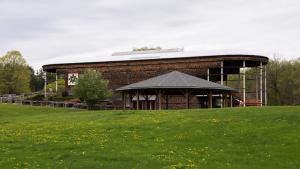 Howes Cave, NY–The Iroquois Museum in Howes Cave, NY, will hold a ribbon-cutting ceremony at 10:30 a.m. on Friday, April 4, celebrating the completion of a $400,000 expansion to its 7,500-square-foot facility.
Howes Cave, NY–The Iroquois Museum in Howes Cave, NY, will hold a ribbon-cutting ceremony at 10:30 a.m. on Friday, April 4, celebrating the completion of a $400,000 expansion to its 7,500-square-foot facility.
“We’re excited to welcome visitors to our beautiful longhouse-inspired museum with a new, light-filled entrance—and to share even more Haudenosaunee culture through expanded exhibit space,” said Steph Shultes, Iroquois Museum Director.
The expansion transforms the museum’s entrance into a spacious shop featuring artisanal goods crafted by Haudenosaunee artists and other culturally significant items. Made possible through the support of the Nicholas J. Juried Foundation, the project allows the museum to reimagine its first impression for visitors.
By enclosing the front porch, the museum has added 750 square feet—allowing the gift shop and reception area to move into the new addition. This frees up space for expanded exhibitions that honor Haudenosaunee art and culture, including archaeological displays and an interactive children’s museum.
The museum opens for the season on Thursday, April 3, with two special exhibitions on view through Nov. 30:
“Once a Tree: Continuity, Creativity, and Connection” explores the deep-rooted significance of trees in Haudenosaunee culture, tradition, and creative expression. Featuring the work of 42 artists and more than 100 objects—including decorative and utilitarian baskets, cradleboards, snowshoes, ladles, lacrosse sticks, toys, instruments, carvings, and sleds—this exhibition highlights the relationship between nature and artistry. Selected from the Museum’s permanent collection, the exhibition was created with guidance from curatorial consultants Terry Chrisjohn III (Oneida), Preston Jacobs (Mohawk), and Sheila Ransom (Mohawk).
"Separated but Unbroken: The Haudenosaunee Boarding School Experience" explores the lasting impact of the Thomas Indian School, once located on the Cattaraugus Reservation south of Buffalo, NY, and The Mohawk Institute near Branford, Ontario. These institutions, which enrolled a significant number of Haudenosaunee students, were part of a larger system that sought to erase Indigenous identities while deeply shaping the lives of those who endured them. Co-curated by Erin Keaton (Mohawk), the exhibition sheds light on Haudenosaunee resilience.
###
 NEWSLETTER
NEWSLETTER
